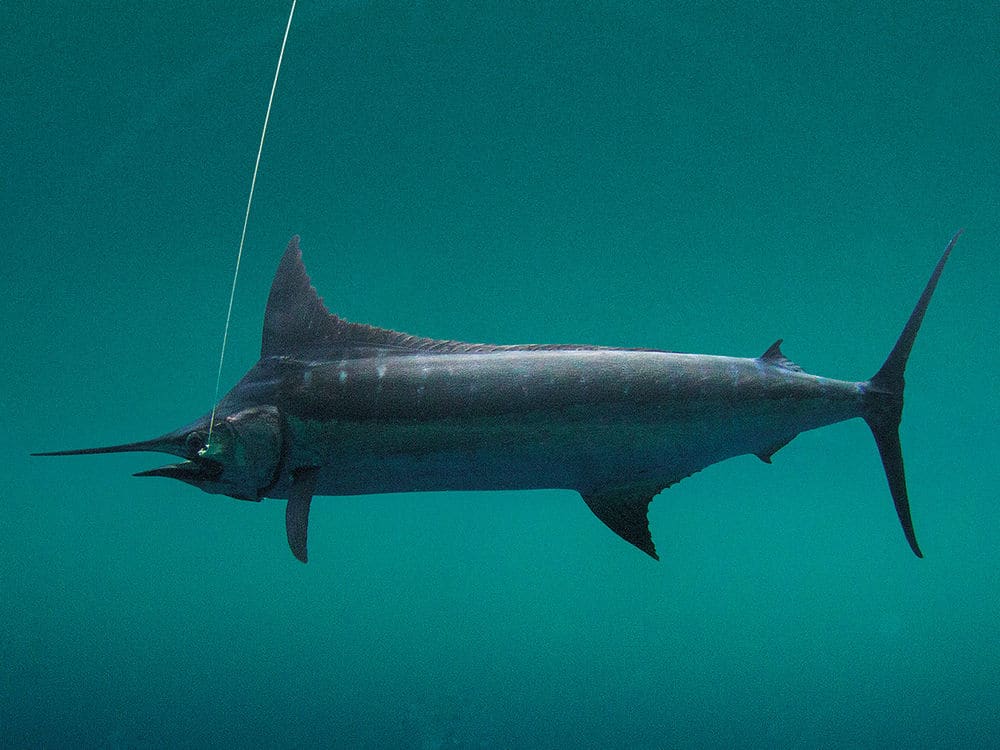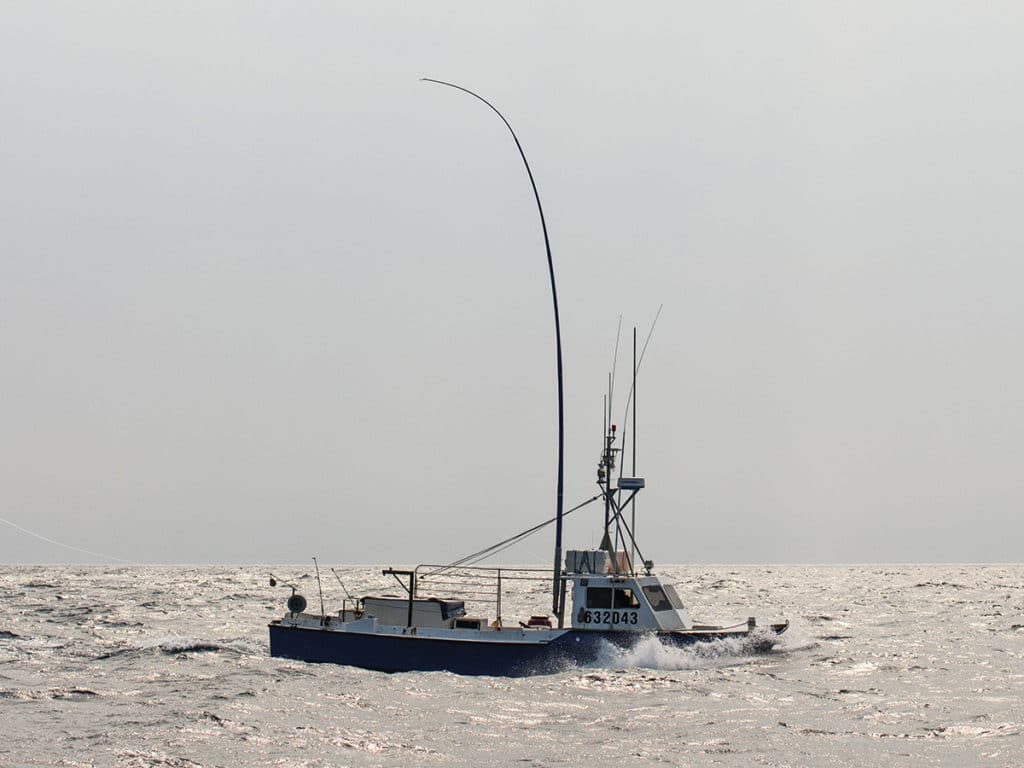
Bluefin tuna surrounded us far off the coast of North Carolina. While holding on to the hardtop, I watched an acre of monster fish boil on the surface. Marks on the fish finder were so thick that the screen displayed a false bottom reading. Linebacker-size bluefin tuna scattered left and right as the boat cleaved the riot.
I turned around, anticipating an explosion on one of our trolled baits. The SeaWitches and Ilanders popped and skipped behind the boat. Our ballyhoo were swimming pretty, but the tuna were not interested. Meanwhile, boats to our left and right had stopped to fight fish.
We’ve all been there: that guy who isn’t catching, surrounded by those who are.
The boats around us, fishing commercially, were outfitted with a 40-foot vertical pole called a green stick. At the time, only a few commercial boats rigged this way. By the next season, half the charter fleet had joined the stick fight. Lately, green sticks are popping up on private boats, and smaller versions are available for boats less than 30 feet. But installing, rigging and using this deadly tactic is a major investment of time and money. Here’s how to do it right.
__________________________________________________________________________________
What’s A Green Stick?
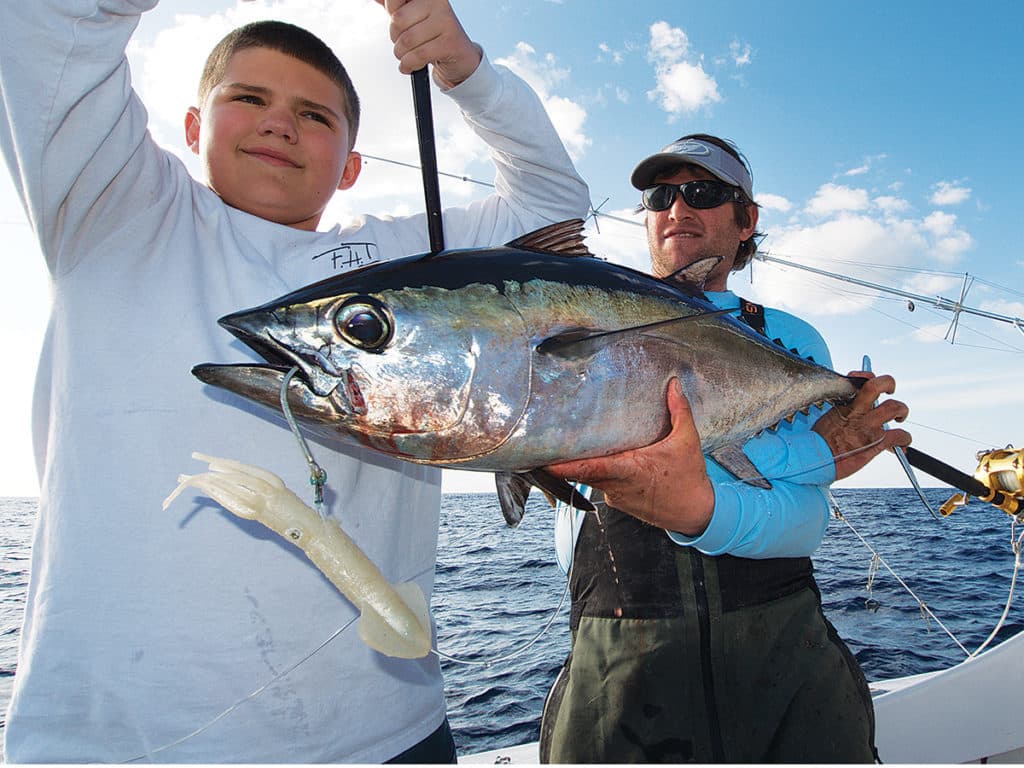
A week after our frustrating, fishless tuna trip, I was rolling in the swells 40 miles off Oregon Inlet in the cockpit of Good Times, a 46-foot Carolina boat sporting a 40-foot-tall green stick.
While Capt. Andy Piland motored the boat at a steady 5 knots, I watched Capt. Tim Hagerich ready the green stick.
The green stick works like a 40-foot, vertical outrigger that elevates the main line to dangle lures over the water. The fiberglass and carbon-fiber pole bends like a giant fishing rod. At the tip of the pole, a tether is attached to the main line with a 200-pound-test breakaway. A big trolling bird stretches the main line to the water. Between the breakaway and the bird, three to six rubber squid dance on the water.
As the boat moves forward, the angler pulls on the retrieve line to make the squid bounce and splash on the surface some 30 feet behind the boat.
A fish doesn’t stand much of a chance pulling against the polyball and hauler commercial fishing gear. Even a 1,000-pound bluefin can be beaten in minutes. For a more sporting approach, recreational anglers are using the green-stick main line as a giant outrigger. The combination of lighter sticks and a multirod spread has made green-stick fishing, or “green sticking,” red hot.
__________________________________________________________________________________
Recreational Greenstick Fishing
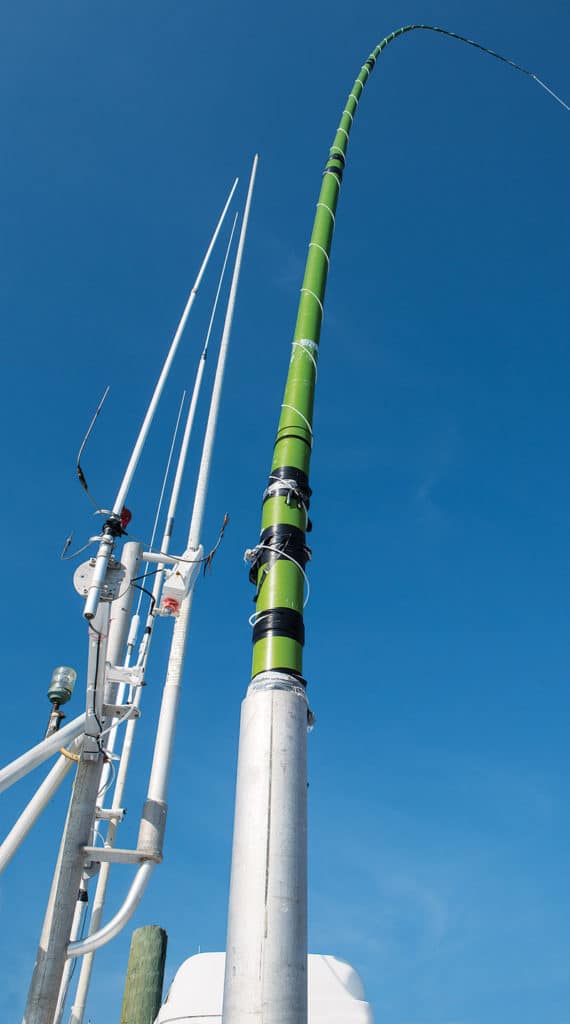
To make green-stick fishing more fun for the crew, Hagerich and Piland rig the green-stick main line on Good Times with breakaway connections snapped to the line coming from 50- and 80-pound-class outfits. Hagerich showed me a longline clip snapped to the main line. He threaded a light zip tie through the ring on the longline clip and the loop at the end of the 200-pound-test wind-on leader coming from the rod. The loop is attached to a 500-pound-class snap swivel that is clipped to a 16- to 25-foot leader sporting a rubber squid.
“The length of the leader depends on the distance from the main line to the water,” says Hagerich. Each boat will have different geometry on the main line and droppers, so there are no exact measurements.
When a fish hits, the zip tie breaks and releases the line. “The zip ties put about 15 pounds of pressure on the line,” Hagerich points out, just enough to set the hook on an exploding tuna.
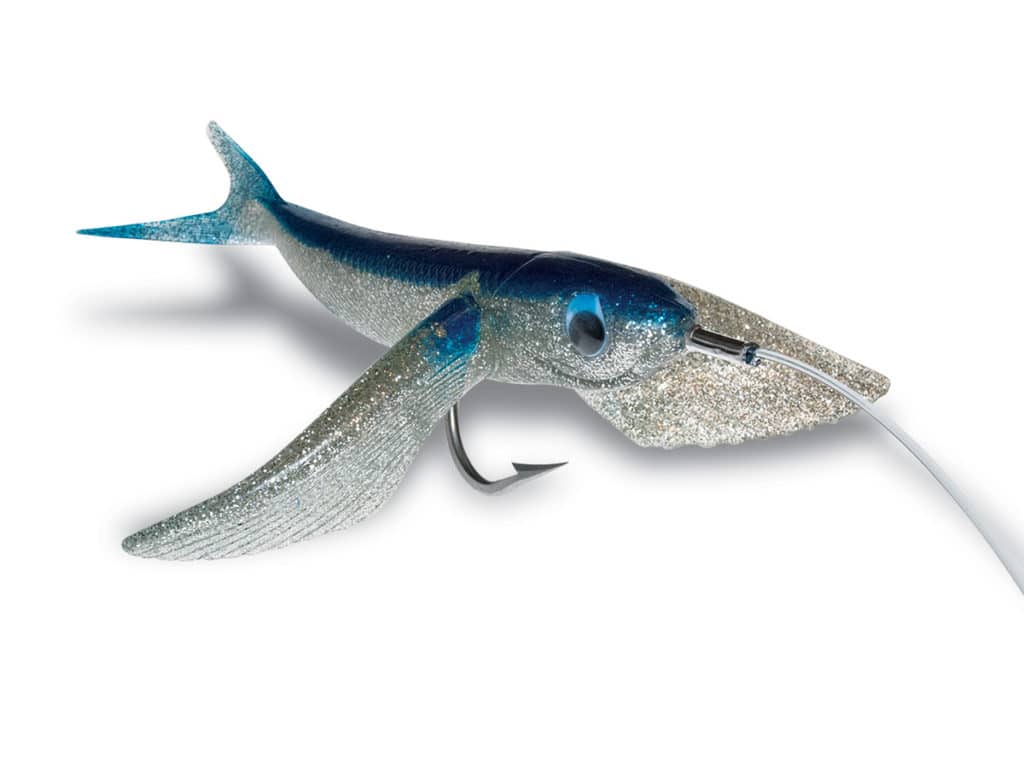
The guys use their stick rig to target bluefin, yellowfin, bigeye and blackfin tuna. With the potential to hook an 800-pounder, green-stick enthusiasts beef up the dropper leader to the squid, called a dangler, to 400-pound-test monofilament.
“Finding a good hook has been the biggest challenge,” Hagerich adds. “A 12/0 Mustad 7691 is the best choice for big bluefin.”
For yellowfin, bigeye and blackfin, he goes with 9/0 to 12/0 Mustad 7698-DT hooks. In the spring, he’ll switch out the rubber squid for rubber flying fish. He’ll even pull a flat-line bait while he’s working the stick to increase hookup.
The breakaways also serve a practical purpose.
“I’d rather fight two tunas on separate rods,” Hagerich says. Instead of having a pair of monster bluefin attached to the same main line, he can fight one off the 130-pound rod connected to the main line, called the hauler, and one from a separate rod.
__________________________________________________________________________________
Trying the Green Stick
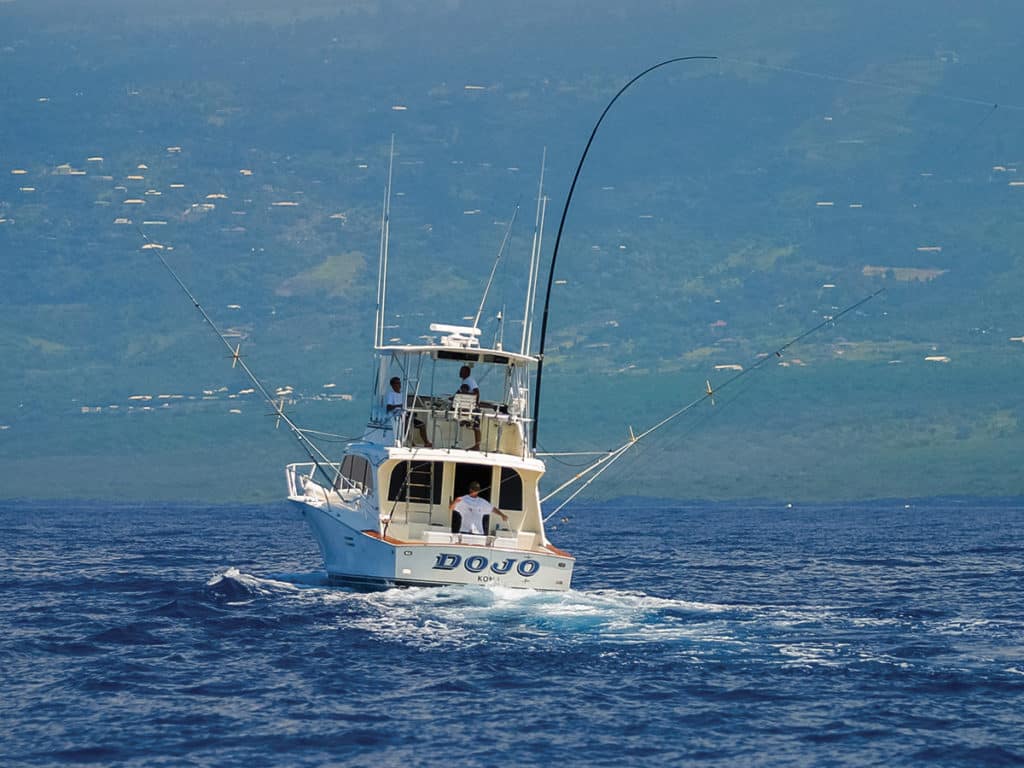
For years, guys in midsize boats have wanted to get in on the green-stick action. But sticking a four-story pole in the middle of a 25-foot boat defies the laws of physics. So the engineers at Hamaguchi, the Japanese green-stick makers, designed the Kona Stick, a slimmed-down version of the original.
“Response has been huge,” says Neil Kanemoto, technical adviser at Pacific Ocean Producers (POP) in Hawaii, a clearinghouse for all things green-stick fishing. Not only has the Kona Stick opened the technique to more anglers, it has made the tactic more user-friendly.
The Kona comes in sizes of 24 and 32 feet. The shorter, narrower, lighter Kona Stick is a great option for boats less than 30 feet. The Kona also uses a smaller, lighter bird that produces less pressure on the stick.
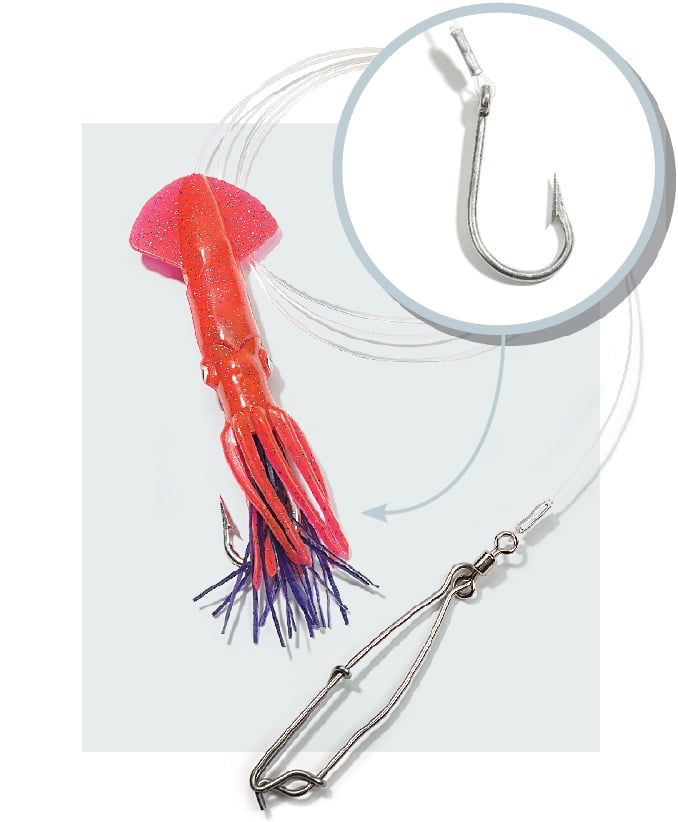
Lure Detail
Mounting the Kona Stick is easier than with traditional green sticks too.
“It doesn’t put as much pressure on a T-top,” Kanemoto says. “And it can be mounted on a base that allows it to be lowered or removed for easier travel.” A series of collars and supports attach the stick to a T-top or hardtop. The simplest installation uses U-bolts to hold the stick to the vertical support, but most skippers go for a custom installation.
“We’ve had customers mount them to T-tops and rod holders and in the gunwale,” Kanemoto says, stressing that the green stick must have solid supports to withstand tremendous pressure of gear, wind, waves and fish.
Unfortunately, the shorter green stick is not as productive as the longer, stiffer Hybrid model. “We find that the Kona Stick produces about 70 percent of the bites you would get on a Hybrid,” Kanemoto explains.
A shorter stick limits the number of droppers, and the softer bend doesn’t give the baits as much action as the stiffer Hybrid stick. But when you’re sitting in the middle of a tuna blitz and the green-stick boats are catching, 70 percent sounds pretty good.
__________________________________________________________________________________
Greenstick Rigging
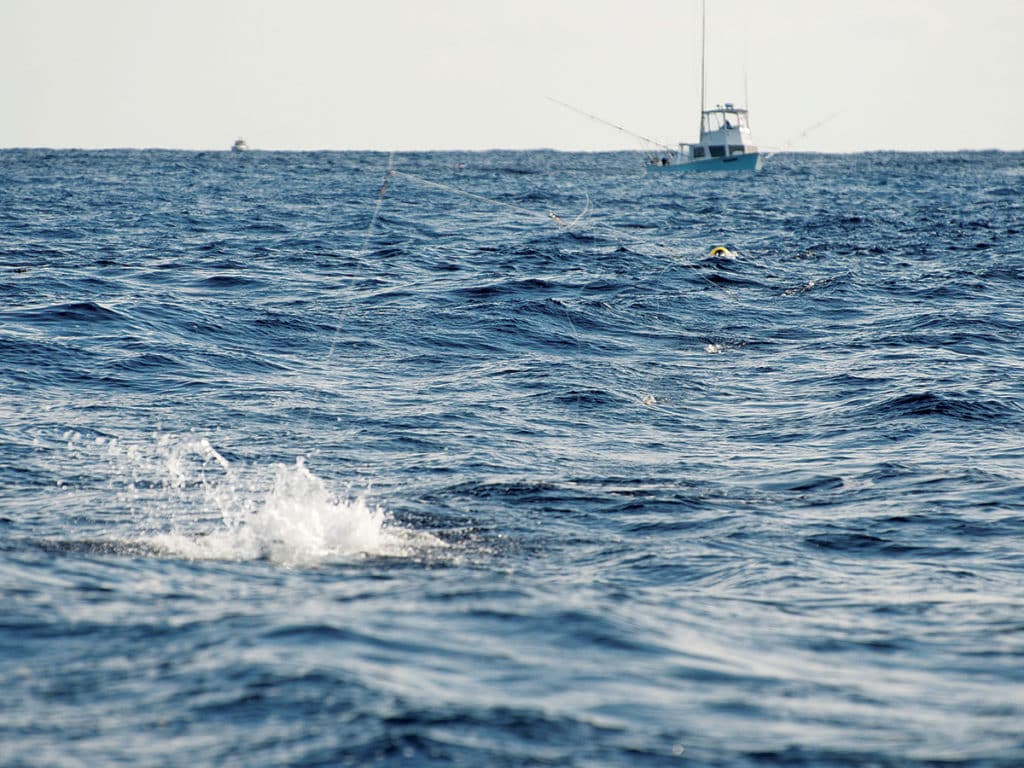
The green-stick phenomenon started in Japan and spread to Hawaii when green-stick designer Yukinobu Shibata and friend Mikio Takuda brought early models to Kona in the 1970s. One of Shibata’s disciples was legendary Hawaiian lure designer and tournament skipper Bomboy Llanes. “Shibata showed me what to do, and in three months I was a master,” Llanes recalls.
“The stick is most effective around schools of tuna under porpoises and around FADs,” the longtime Kona captain says. That’s because the technique allows the skipper to dangle baits over breaking fish or structure.
In fact, when the boat is in a turn and pivoting around the bird, the angler can bounce the baits directly over the school of fish. “If I mark fish at 40 fathoms, I can get them to come up to the squid,” Llanes says.
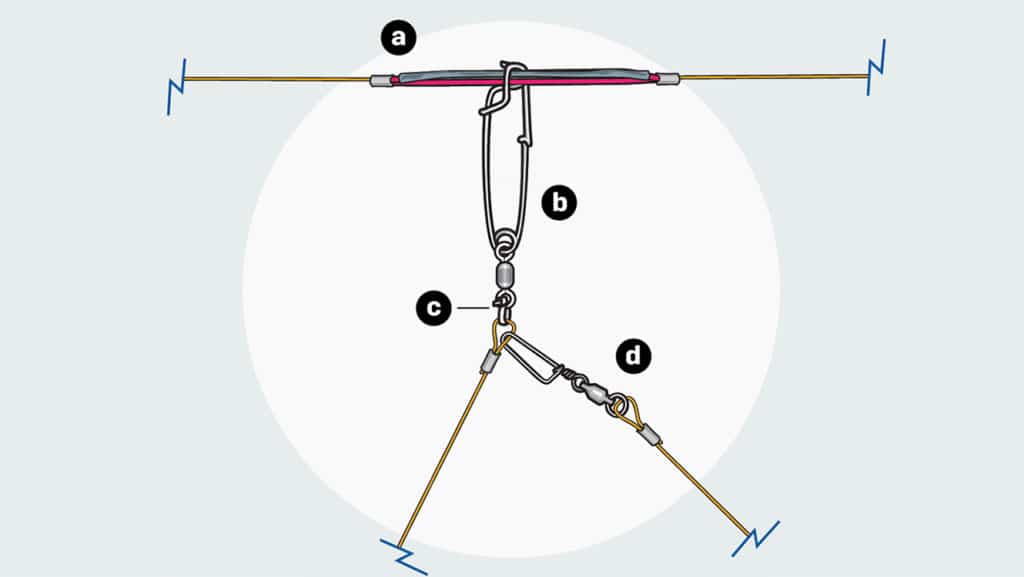
Breakaway Clip
Keep the baits dancing to draw in the fish. “You can really pop and jiggle the main line to get a bite,” Llanes says. He trolls at 5.5 knots but will add or subtract speed to pull more bites. Llanes tries to keep the sun at an angle so fish can see the squid. He likes to approach a school or buoy up-current to tempt the biggest fish.
Llanes uses four or five danglers ending with a rubber squid. His favorite colors are oil brown and dark green, but he’ll switch to white, neon green or hot pink depending on the fish. “I watch the other boats with binoculars to determine my lure color,” he says with a laugh.
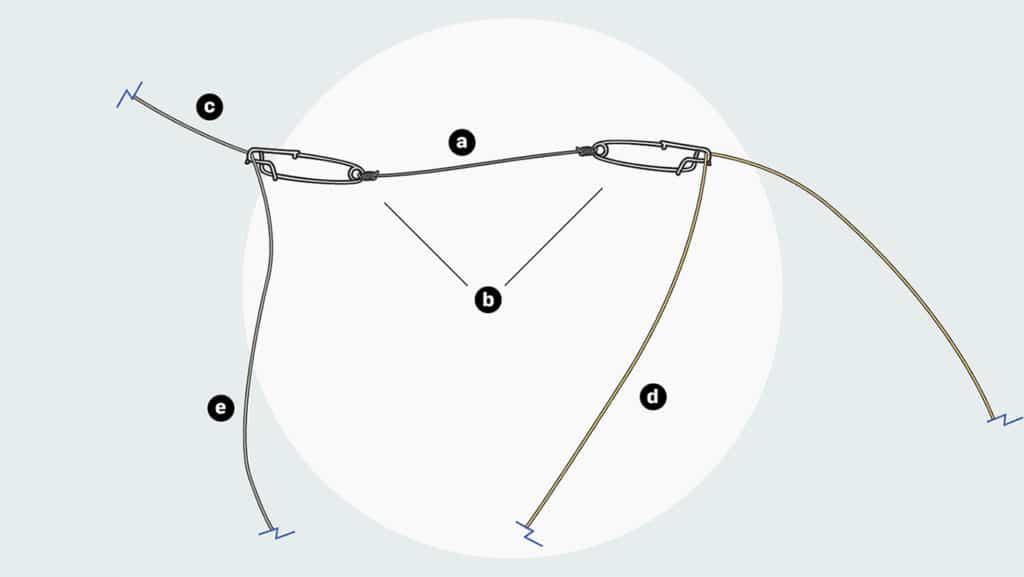
Breakaway Line
The key to the system is a balanced rig that spreads the droppers out for optimal tension on the main line, Llanes insists. “If the rig is balanced and the droppers are the correct length, the mate will only have to move the action line 5 or 6 inches to make the baits jump.” Adjust the length of the dropper and the boat speed to get the correct balance. “Start with the lures high off the water,” he instructs. “Then pull the action line to bounce the squid off the waves.”
Another trick Llanes likes is attaching the hook to the leader with Dacron. “That keeps the connection soft so the fish doesn’t feel the leader if it misses the bait,” he explains. This encourages the short biter to come back for another try. “Everyone fishes the green stick differently,” Llanes says. He encourages anglers to experiment and discover what works for them.
__________________________________________________________________________________
Greenstick Rig and Illustration
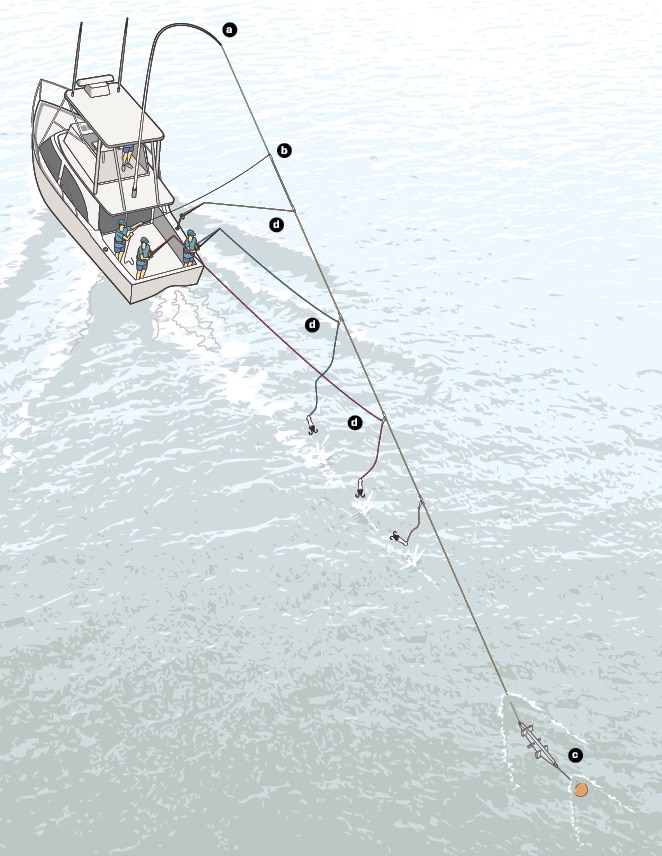
A line from the tip of the green stick holds the main line high off the water [a] to dangle squid baits. The line from the green stick is attached to the main line with a section of 200-pound mono [b]. A heavy trolling bird and polyball stretch the main line to the water. The main line acts like a giant vertical outrigger [c]. Lines from rods in the cockpit run to the main line through breakaway connections [d]. When a fish hits one of the cockpit lines, it breaks away from the main line and the angler fights the fish from the rod. If a fish hits a bait on the hauler, the breakaway to the tether snaps, and the crew cranks in the fish with the hauler.
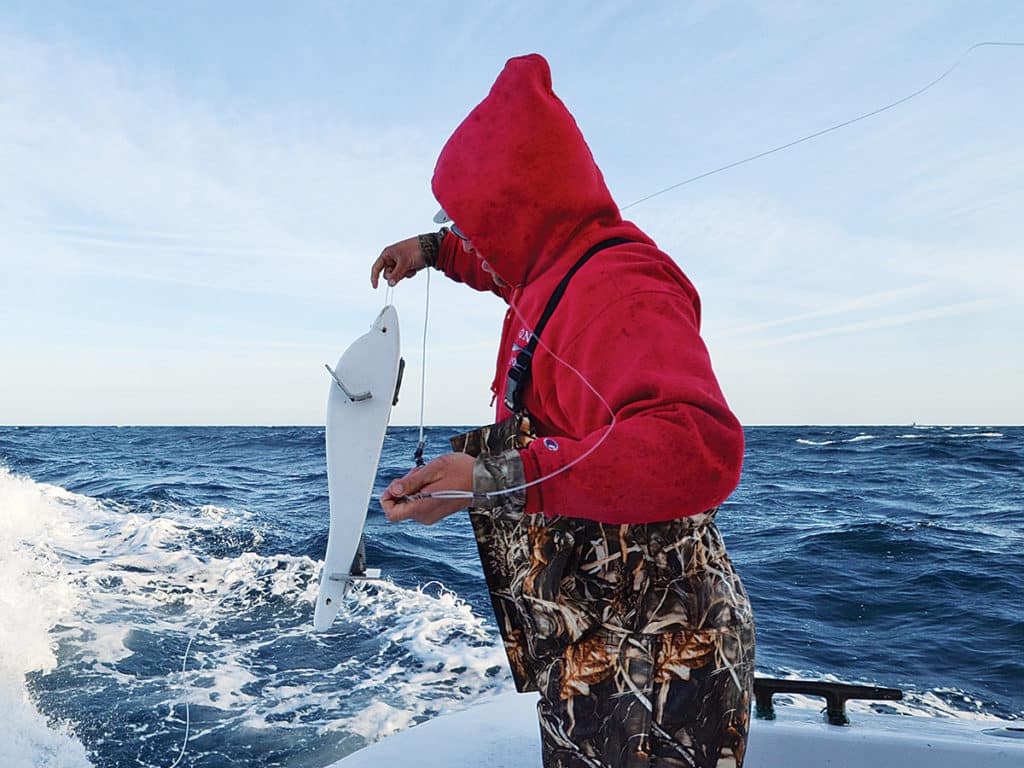
__________________________________________________________________________________
Greenstick Fishing Takes Over the East Coast
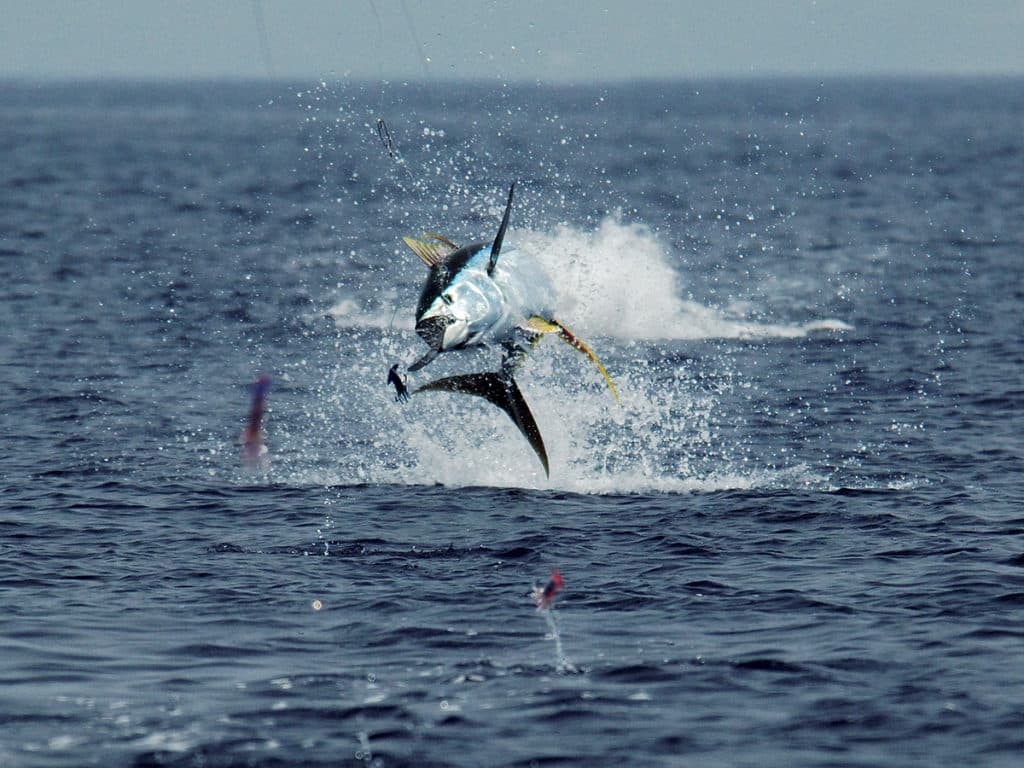
After green-stick fishing was established in Hawaii, it moved halfway around the planet to the storied waters of North Carolina’s Outer Banks. “A longline boat that had spent some time in Hawaii ended up in Wanchese,” remembers Mark Cordeiro, owner of Sea and Sound Tackle. The boat still had a stick, but the captain didn’t use it. “Some locals looked up information and figured it out,” Cordeiro says. The rest is history.
The technique spread like wildfire through the tuna-fishing community. First commercial fishermen, then charter captains and now recreational small-boat anglers are jumping on board. “They’re selling like hotcakes,” says Cordeiro, who’s the North Carolina distributor for POP Hawaii.
Many of his customers purchase the stick and rigging but have no idea how to use it. “They see it on another guy’s boat and they want one too,” Cordeiro says, laughing. He’s been using a green stick for 25 years. Currently, he has a 32-foot Hybrid rigged to his 25-foot boat. “I fish solo, and the system is easy for me to operate.”
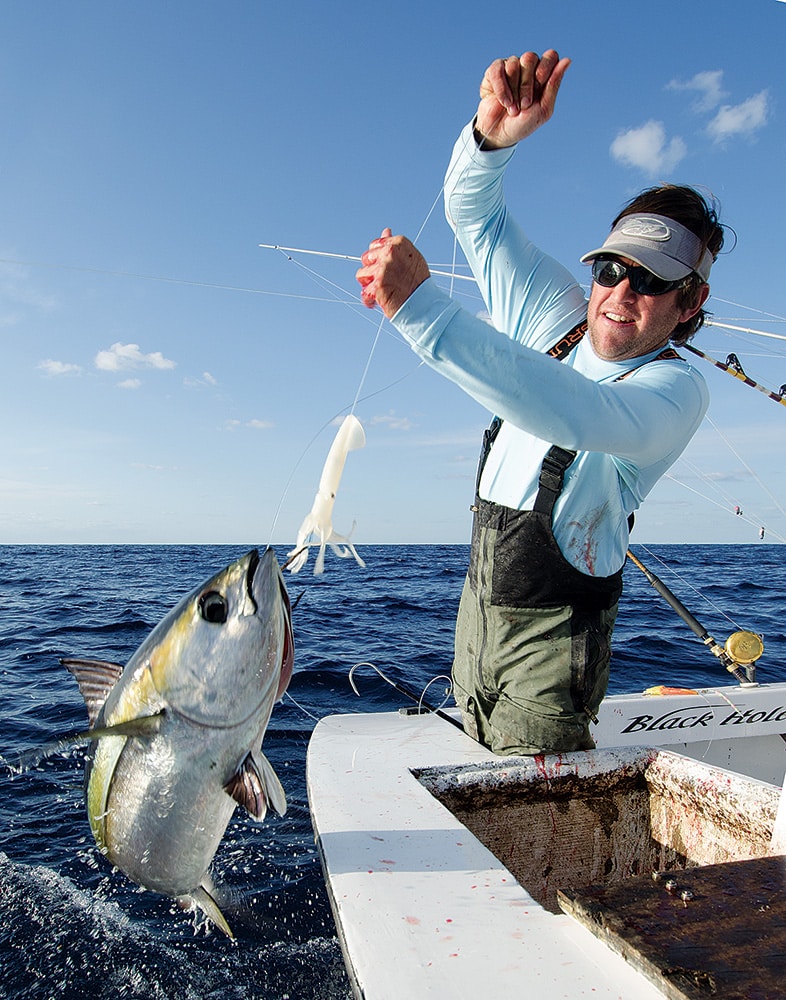
To rig a new system, Cordeiro recommends taking the gear out on a calm day. Adjust the length of the droppers and the main line until the squid dance off the surface. The squid should dangle, even when the boat is in a turn. “If the squid drop into the water, you defeat the purpose of the green stick,” he points out.
Once he gets the droppers the correct length, Cordeiro marks each on the gunwale of his boat. When he needs to replace a dropper, he uses the marks to measure out a new leader.
Cordeiro says a smaller boat actually has an advantage. “The boat rocks more in the waves,” he explains. “And that gives the lures more action.” He admits the theory holds true until seas get too rough. A smaller boat and short stick also keep the bird closer to the boat so it tracks better.
A “kill zone” is the best way I can describe the airspace between the water and the squid. That’s because the first time I watched a big tuna explode from the water to snatch a fake squid, I damn near had a heart attack.
About the Author
After sweating and cursing for two hours while cranking in a 500-pound bluefin tuna 20 years ago, Ric Burnley retired from the fighting chair and took up photography and writing. He currently lives in Virginia Beach, Virginia, where he teaches high school students and fishes for anything that doesn’t require a harness.
__________________________________________________________________________________
From the Surface to the Depths
